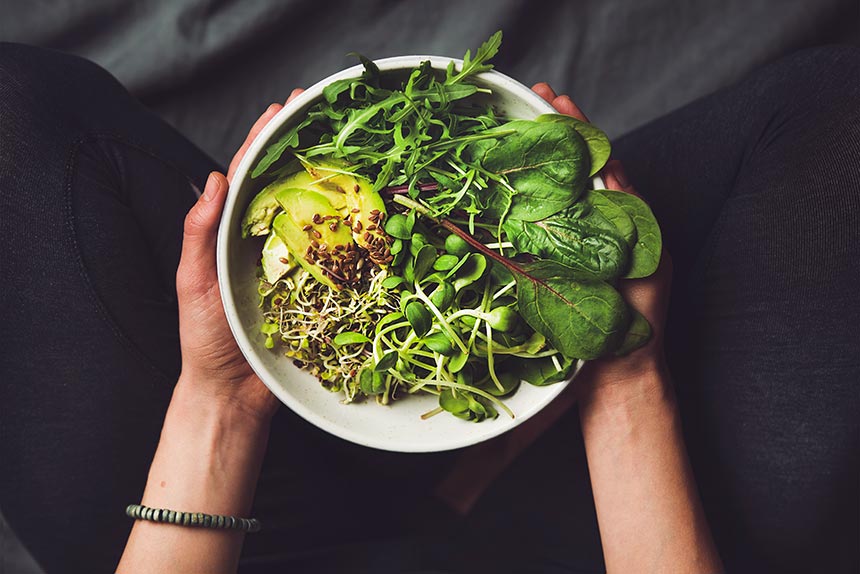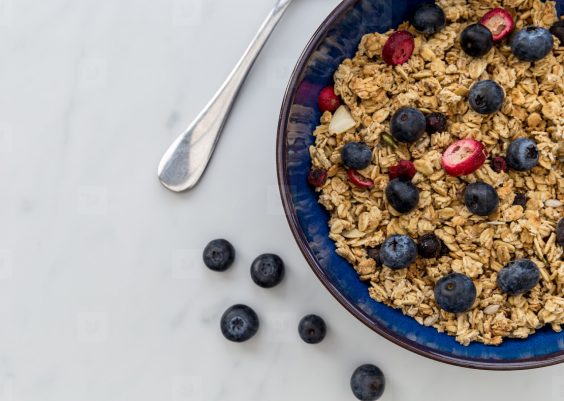Sneak veggies into pasta

Eating well doesn’t have to mean switching up your entire diet. Small changes can have a big impact, without sacrificing taste, flavor, or the foods you love. For example, go ahead and eat that plate of pasta—you won’t even remember these healthy special ingredients. “A great menu makeover item is spaghetti with Bolognese sauce, replacing half the meat in the sauce with more vegetables such as mushrooms, or adding mushrooms and lentils,” says Laura Moore, RD, director of the dietetic internship program at The University of Texas Health Science Center at Houston (UTHealth) School of Public Health. You can also use whole-wheat pasta and even pastas made from chickpeas or beans. This method, she says, adds protein and fiber which keeps you satisfied, but reduces the saturated fat. “Alternatively, if you purchase your sauce, buy low-sugar sauce and add pureed carrots,” she says, which is a healthier way to add sweetness. Erin Palinski-Wade, RD, CDE, author of Belly Fat Diet for Dummies, has another suggestion: Simply chop up a tomato and add it to pre-made sauce for added fiber and volume. Bonus for busy families: A recent Australian study showed that eating three to four servings of veggies a day can reduce stress levels. Here are eight clear signs you’re not eating enough vegetables.
Make over meatloaf and other comfort foods

If “healthy eating” sounds like you won’t be able to indulge, try making some easy swaps to get more nutrients out of your comfort foods. For meatloaf, an easy change is the addition of ground turkey, according to Jeanne Piga-Plunkett, RD, co-director of the dietetic internship program at The University of Texas Health Science Center at Houston (UTHealth) School of Public Health. “This can decrease the fat and maintain the mouthfeel that so many enjoy when eating meatloaf,” she says. Plus, “adding oatmeal that’s been soaked in water or milk in place of breadcrumbs increases the fiber,” Moore says. Try incorporating veggies, mushrooms, or lentils here as well, with a teaspoon of Worcestershire sauce to maintain the savory taste. If you’re ready to go meatless, a study from the University of Minnesota showed that bean-based meatloaf was just as filling and satisfying as a beef-based one. But even if you’re not willing to go that far, any amount of veggies can be added to just about any comfort food to up the nutrient value: grilled cheese, casseroles, burgers, and mac and cheese are great places to hide them. Find out the 10 comfort foods professional chefs always cook at home.
Switch out your sides

You probably don’t want to give up your starchy side dish—for many of us, it’s what leaves us feeling full and satisfied. But, you can make it a little healthier by gradually swapping out white rice. “We recommend starting with a blend of white and brown rice, or white rice and lentils or quinoa,” Moore says. “The lentils and quinoa add more fiber and protein, reducing the transit time and slow the rise of blood sugar—while still keeping the taste of white rice.” Quinoa sounds fancy, but it’s just as easy to make as rice—and studies have shown that molecules abundant in quinoa called flavonoids have antioxidant properties. A dash of herbs like parsley or thyme ups the flavor (fresh is best, but you can also use what you have on your spice rack). Other healthier side swaps include sweet potatoes instead of white, or you can mix them if you prefer. A better option for “fries” is regular or sweet potatoes roasted in the oven, dipped in marinara sauce instead of sugary ketchup—a great way to get kids to eat them. Check out these 15 creative recipes for quinoa.
Content continues below ad
Tweak your breading

Who doesn’t like breaded chicken? You might think eating healthy would mean skipping the breading all together, and while that is an option, it’s not the only one. “Dip chicken or fish in seasoned whole-wheat flour, shake, then dip in an egg or egg white, then coat with whole-wheat breadcrumbs,” Piga-Plunkett says. “This is an easy way to add whole wheat and no one will notice the change.” Moore suggests using quinoa instead of breadcrumbs as well. Another option for added protein is ground almonds, which provide a crunchy and nutty coating. You’ll feel fuller longer with a healthy “breading” rather than plain chicken, which will keep you from snacking later on. You’ll definitely want to try this recipe for pistachio-orange crusted chicken.
Soup up your salad

You might think salads are already healthy—but there’s always room for improvement. “Swap the iceberg lettuce in your salad for baby spinach for an extra boost of nutrients,” Palinski-Wade suggests. You don’t want to get bored with the same old salad and end up ordering lunch out, so keep it interesting. “Do not limit yourself to just the traditional blends; add fresh vegetables, herbs, and fruit to give it a boost,” Piga-Plunkett says. “Swiss chard is the new kale—it’s very versatile and does not require the same amount of work to add to a salad.” Add nuts for a crunch instead of croutons. In addition, a study from Purdue University found that adding eggs to salads upped the amount of vitamin E absorbed from the veggies. For a healthier creamy dressing with less saturated fat, try Greek yogurt with a little olive oil, lemon juice, vinegar, and spices. And spice up the ease of preparation—and presentation—by taking your salad to work in a mason jar, with the dressing on the bottom. Just pour into a bowl and your salad’s mixed! To start, try these delicious, good-for-you mason jar salads.
Add avocado for a creamy substitute

Avocado works as a secret ingredient in anything from savory to sweet dishes, and is super healthy. A recent study from the University of Southern California found that veggies that contain a lot of potassium, like avocados, can even lower blood pressure. “Replace half of the butter in a recipe with mashed avocado to boost the nutrient content of the meal while reducing the overall saturated fat, cholesterol, and calories,” Palinski-Wade says. You can also use it instead of cheese or mayo on your sandwich for a surge of healthy fats and nearly 20 vitamins and minerals. “Because of avocado’s texture, it is an easy item to blend into soup to give it that creamy texture we love,” Piga-Plunkett says. Surprisingly, no one will know if you add it to brownies, chocolate cake, or frosting. For a rich chocolate pudding, mix it with milk, cocoa, and vanilla extract or honey. Find out five powerhouse benefits of avocado you didn’t know about.
Content continues below ad
Make flavored water instead of soda or juice

Too many of our calories are coming from sugary drinks, which don’t fill you up and might actually make you hungrier—a study from Harvard found that women who increased the frequency of sugar-sweetened drinks added 358 calories daily and gained more weight, while women who reduced their intake cut 319 calories and gained less weight. So what can you do? “Swap out the soda for seltzer splashed with 100 percent juice, which gives the same sweet carbonation without the added sugar, and a bonus of antioxidants,” Palinski-Wade says. Or, up the flavor of water with herbs like mint, basil, thyme, or rosemary. Adding whole fruit is another option—throwing in a few slices to tap water is a quick way to cut out sugar without losing flavor. “We use fresh fruits such as oranges, limes, and lemons in our flavored water,” Moore says. “We also use watermelon, pineapple, and various berries. Cucumber and mint make a great combination.”
Pump up your pancakes and other breakfast options

Pancakes are a great breakfast treat—who’d want to give those up? Instead, just make a few small changes: Use whole-wheat flour instead of white, and add fruit (or even sweet veggies like pumpkin) instead of chocolate chips. “My favorite pancake recipe is whole-wheat flour with blueberries, cinnamon, Greek yogurt, almond milk, honey, and vanilla, along with your baking powder, soda, salt, and eggs,” Moore says. Instead of syrup, top with an easy fruit sauce (fruit, orange juice, and cinnamon) for sweetness with less sugar. If you prefer eggs for breakfast, Palinski-Wade suggests tossing in some frozen spinach for a fiber and iron boost. Even plain old cereal can be make healthier: “Slice up a banana or add a handful of berries to squeeze in an extra serving of fruit,” she says.
Enjoy fruity desserts

We know, fruit doesn’t feel like dessert. But if you make an ice cream substitute with it, it can be! “Frozen bananas have that ‘ice cream’ feel when pureed,” Moore says. “The great thing is you can add all sorts of healthy ingredients such as nut butters or another fruit like strawberries. Substitute frozen mangoes for the bananas and top with diced pineapple and slivered almonds for a tropical treat.” If you just can’t give up real ice cream, and making it homemade is not your thing, “replace one scoop with a fruit topping such as sliced strawberries instead for a sweet way to add fiber and vitamin C,” Palinski-Wade says. We’ve already told you how avocado can be used in sweet treats, but Piga-Plunkett has some other suggestions when baking. “Try decreasing added sugars with naturally sweet substitutions including pureed dates, raisins, figs, bananas, spices like cinnamon, nutmeg, allspice, and cloves,” she says. In addition to avocado, oil or butter can be replaced with bananas, pureed berries, or applesauce. Here are eight legitimate reasons you should eat dessert every day.
Content continues below ad
Snack smarter

The goal of a healthy eating plan is to make meals that will keep you fuller, longer—but you’re still going to want a snack sometimes. Don’t let that derail you. Moore suggests 100-calorie snacks that consist of five grams of fiber or more, less than one gram of saturated fat, and are made with whole grains, low sodium, and less than 10 grams of sugar. In a recent survey, 63 percent of North Americans said they had snacked on chips in the past month—but there are healthier options, like these snacks. “If you need a salty and crunchy snack, opt for air-popped popcorn over chips for a higher fiber, higher volume snack with fewer calories and fat,” Palinski-Wade suggests. Instead of butter, top popcorn with spices you have in your cupboard, like paprika, garlic powder, or oregano. Snacks with protein, like hard-boiled eggs and nuts, will keep you satisfied longer. Keep hummus in the fridge, and snack on it with whole-grain pita bread. “Chickpeas are a good source of protein and fiber,” Moore says. You can even make your own healthy hummus with pureed beets, carrots, pesto, and seasonings like cumin and smoked paprika, Moore suggests. (Bonus: You can use this same dip as a spread on sandwiches or wraps, Piga-Plunkett says.) What are the 17 on-the-go snacks nutritionists always keep in their bags?
Lighten up your pizza

We wouldn’t dream of asking you to give up pizza. It’s one of our favorite foods—recent research by the USDA found that 13 percent of the American population consumes pizza on any given day. But you can tweak it to make it a bit healthier. Instead of tons of mozzarella, order it with half the cheese and twice the sauce—or, load it up with veggies. Choose thin crust to cut down on refined carbs. If you’re making your own, forget the dough completely, which takes a long time to rise anyway. Instead, try a cauliflower pizza steak for a quick and easy crust substitute. “Slice a cauliflower head into slices and bake in a 375-degree oven for 15 minutes,” Moore says. “Take out and add your sauce and toppings, and heat in the oven until it’s bubbly.” Another option is to grind up the cauliflower, add Parmesan cheese, Italian seasonings, and an egg, press into a pizza pan, and bake, she suggests. Then add your toppings and bake again—it will come out like real crust, but with more vitamin C and iron from the cauliflower.
Content continues below ad





